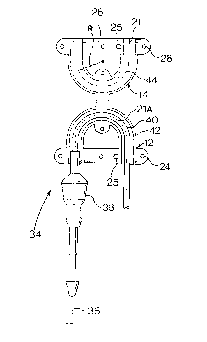Une partie des informations de ce site Web a été fournie par des sources externes. Le gouvernement du Canada n'assume aucune responsabilité concernant la précision, l'actualité ou la fiabilité des informations fournies par les sources externes. Les utilisateurs qui désirent employer cette information devraient consulter directement la source des informations. Le contenu fourni par les sources externes n'est pas assujetti aux exigences sur les langues officielles, la protection des renseignements personnels et l'accessibilité.
L'apparition de différences dans le texte et l'image des Revendications et de l'Abrégé dépend du moment auquel le document est publié. Les textes des Revendications et de l'Abrégé sont affichés :
| (12) Demande de brevet: | (11) CA 2246264 |
|---|---|
| (54) Titre français: | DISPOSITIF UTILISE POUR ELIMINER LES TORSIONS |
| (54) Titre anglais: | A KINK INHIBITING DEVICE |
| Statut: | Réputée abandonnée et au-delà du délai pour le rétablissement - en attente de la réponse à l’avis de communication rejetée |
| (51) Classification internationale des brevets (CIB): |
|
|---|---|
| (72) Inventeurs : |
|
| (73) Titulaires : |
|
| (71) Demandeurs : |
|
| (74) Agent: | SMART & BIGGAR LP |
| (74) Co-agent: | |
| (45) Délivré: | |
| (22) Date de dépôt: | 1998-09-02 |
| (41) Mise à la disponibilité du public: | 1999-03-02 |
| Licence disponible: | S.O. |
| Cédé au domaine public: | S.O. |
| (25) Langue des documents déposés: | Anglais |
| Traité de coopération en matière de brevets (PCT): | Non |
|---|
| (30) Données de priorité de la demande: | ||||||
|---|---|---|---|---|---|---|
|
Dispositif utilisé pour éliminer les torsions dans une section de tube souple incurvée, en particulier un tube d'intraveineuse ou de perfusion. Le dispositif comprend une paire de demi-coquilles en U, unies dos-à-dos au niveau de leur section de boucle, au moyen d'une charnière intégrée. Les demi-coquilles sont dotées l'une et l'autre de rainures transversales semi-circulaires et comportent des surfaces d'appui munies de tiges et d'ouvertures complémentaires pour assurer leur assemblage. Les demi-coquilles ont toutes deux un rayon de courbure (K) supérieur au rayon de courbure maximal auquel un tube souple, non supporté, commence à se tordre.
A kink inhibiting device is provided for inhibiting kinking in a length of
curved flexible tubing, and in particular IV or drip tubing. The device
comprises a pair of U-shaped shell halves which are joined back-to-back at
their bight portions by an integral hinge formation. The shell halves each
define channels having semi-circular cross-sectional profiles, and are formed
with connecting lands carrying studs and complemental apertures for
allowing the shell halves to mate with one another. The shell halves each
have a radius of curvature (R) which is greater than the maximum radius of
curvature at which the flexible tubing starts to kink when unsupported.
Note : Les revendications sont présentées dans la langue officielle dans laquelle elles ont été soumises.
Note : Les descriptions sont présentées dans la langue officielle dans laquelle elles ont été soumises.

2024-08-01 : Dans le cadre de la transition vers les Brevets de nouvelle génération (BNG), la base de données sur les brevets canadiens (BDBC) contient désormais un Historique d'événement plus détaillé, qui reproduit le Journal des événements de notre nouvelle solution interne.
Veuillez noter que les événements débutant par « Inactive : » se réfèrent à des événements qui ne sont plus utilisés dans notre nouvelle solution interne.
Pour une meilleure compréhension de l'état de la demande ou brevet qui figure sur cette page, la rubrique Mise en garde , et les descriptions de Brevet , Historique d'événement , Taxes périodiques et Historique des paiements devraient être consultées.
| Description | Date |
|---|---|
| Inactive : CIB de MCD | 2006-03-12 |
| Inactive : CIB de MCD | 2006-03-12 |
| Inactive : CIB de MCD | 2006-03-12 |
| Demande non rétablie avant l'échéance | 2002-09-03 |
| Le délai pour l'annulation est expiré | 2002-09-03 |
| Réputée abandonnée - omission de répondre à un avis sur les taxes pour le maintien en état | 2001-09-04 |
| Demande publiée (accessible au public) | 1999-03-02 |
| Inactive : Correspondance - Formalités | 1998-12-02 |
| Inactive : CIB attribuée | 1998-11-21 |
| Inactive : CIB en 1re position | 1998-11-21 |
| Symbole de classement modifié | 1998-11-10 |
| Inactive : CIB attribuée | 1998-11-10 |
| Inactive : Certificat de dépôt - Sans RE (Anglais) | 1998-10-21 |
| Exigences de dépôt - jugé conforme | 1998-10-21 |
| Demande reçue - nationale ordinaire | 1998-10-16 |
| Date d'abandonnement | Raison | Date de rétablissement |
|---|---|---|
| 2001-09-04 |
Le dernier paiement a été reçu le 2000-08-31
Avis : Si le paiement en totalité n'a pas été reçu au plus tard à la date indiquée, une taxe supplémentaire peut être imposée, soit une des taxes suivantes :
Veuillez vous référer à la page web des taxes sur les brevets de l'OPIC pour voir tous les montants actuels des taxes.
| Type de taxes | Anniversaire | Échéance | Date payée |
|---|---|---|---|
| Taxe pour le dépôt - petite | 1998-09-02 | ||
| TM (demande, 2e anniv.) - petite | 02 | 2000-09-05 | 2000-08-31 |
Les titulaires actuels et antérieures au dossier sont affichés en ordre alphabétique.
| Titulaires actuels au dossier |
|---|
| JUSTIN COLLEN |
| Titulaires antérieures au dossier |
|---|
| S.O. |